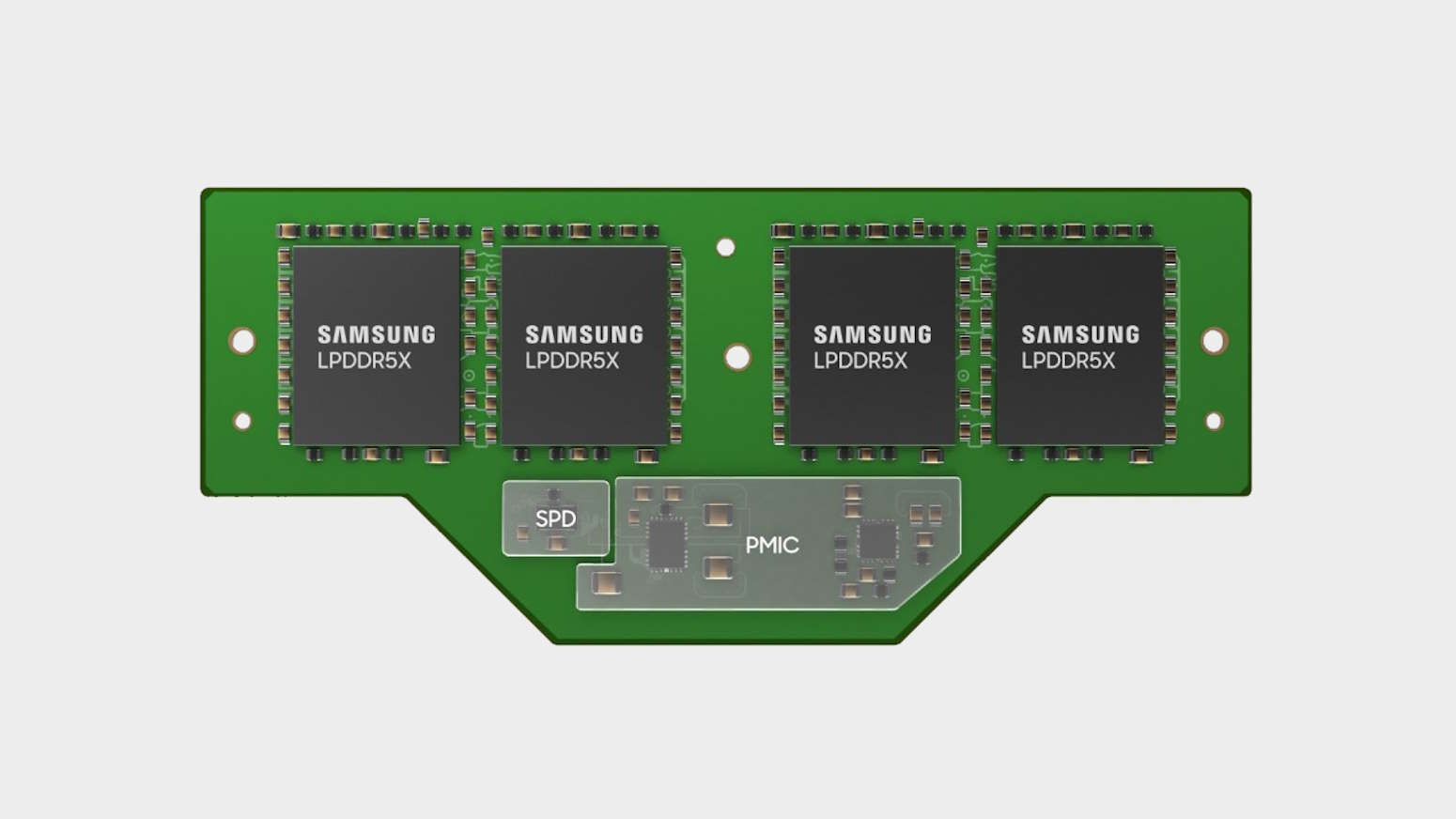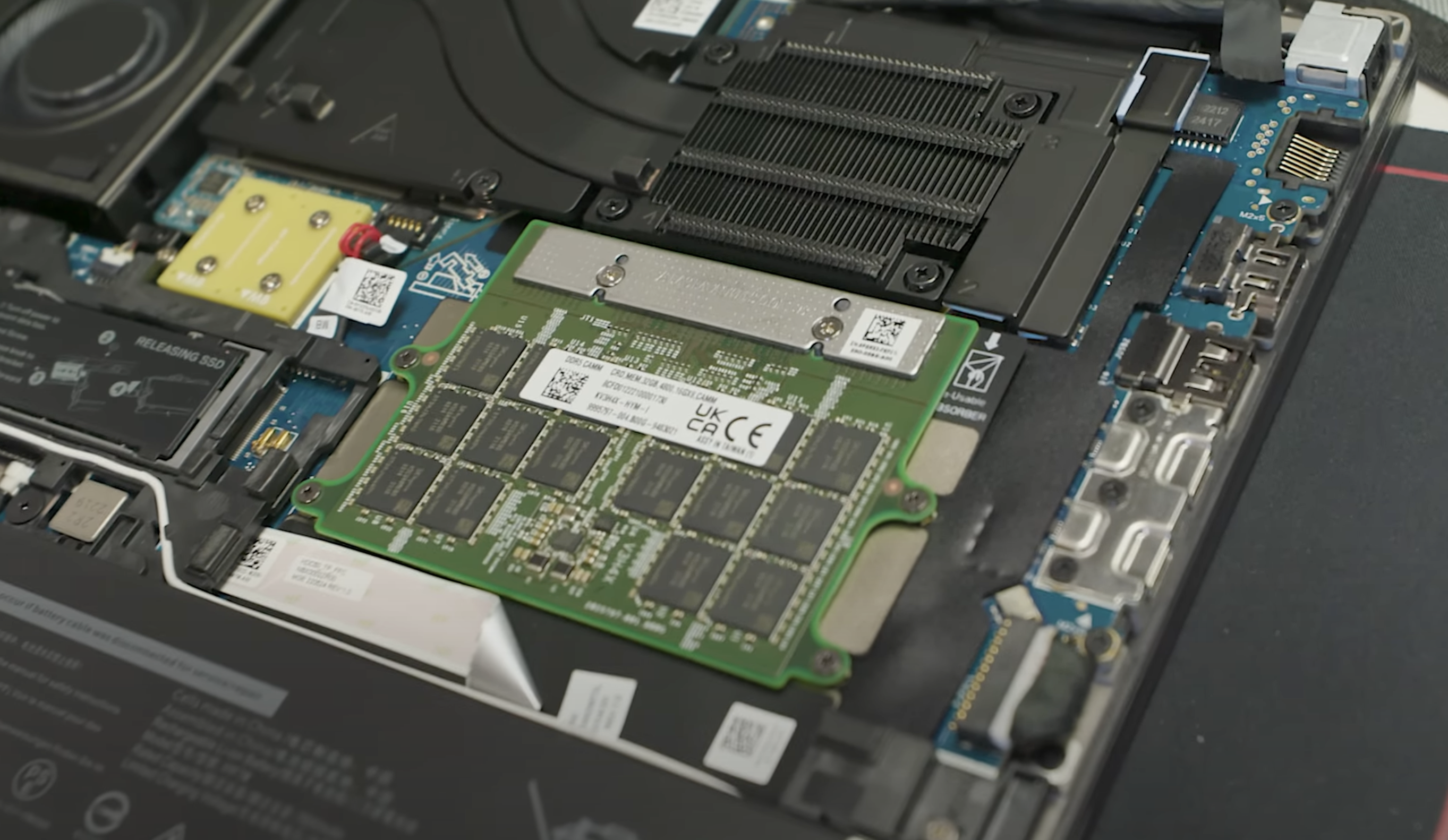Samsung's new low power, high performance memory range could be a serious boon for compact gaming laptops
The ickle upgradeable memory modules offer higher performance than traditional SO-DIMMS with most of the benefits of soldered-on memory.

Samsung's new laptop memory range promises upgradeable memory without the performance glass ceiling of SO-DIMMs. Its newly announced range of Low Power Compression Attached Memory Modules (LPCAMMs) will dramatically shrink the amount of space normally given over to traditional laptop memory modules, but don't expect that to mean a reduction in the number of soldered-on solutions.
Right now, when it comes to DDR5 in laptops you either have replaceable SO-DIMMs or, where size is a concern, you get the memory chips themselves soldered onto the mainboard itself. That's the better solution for compact laptops, as it takes up less space and can be faster, too. But it means manufacturers have fewer options for different memory configurations—hence why something like the Asus ROG Zephyrus G14 has a 32GB limit as it has 16GB soldered onto the board, with an optional 16GB available via SO-DIMM.
But if you're going for that half-and-half method, you are restricted to the speeds of the SO-DIMM socket and, at the moment at least, that means you are restricted to 6400MT/s modules. And if you want to go for the low power LPDDR5, which offer higher speeds and lower power, they have to be soldered onto the board.
Samsung's new LPCAMMs, however, can bring you the best parts of SO-DIMMs and LPDDR5 into one handy package. You get replaceable memory modules, with higher speeds, and they come in a super small form factor, up to 60% smaller than a traditional SO-DIMM setup.
The Korean company has shown off renders of an LPCAMM module running with 4 LPDDR5X packages mounted on it, with a vastly smaller footprint than a dual SO-DIMM solution.
Essentially the LPCAMM is attached to the motherboard, with socketed connections directly underneath the memory packages to minimise the distance of wiring between the board and chips. This is theoretically similar to the Compressed Attached Memory Modules (CAMM) that Dell has been working on for years, but has yet to get approved, but Anandtech notes the two are physically and electronically incompatible.
LPCAMM is due to be tested in "next-generation systems with major customers this year," according to Samsung, but actual commercially available devices won't arrive until well into 2024. But what those systems might be… well, don't expect handhelds or ultrathin laptops to stop using soldered-on memory. Soldered memory still has advantages over LPCAMM in those situations—it has an even smaller footprint, can still be high speed, and has shorter wires and therefore lower power—and so the benefits of having a removable memory module are thoroughly offset.
Keep up to date with the most important stories and the best deals, as picked by the PC Gamer team.


Best CPU for gaming: The top chips from Intel and AMD.
Best gaming motherboard: The right boards.
Best graphics card: Your perfect pixel-pusher awaits.
Best SSD for gaming: Get into the game ahead of the rest.
We've also seen Intel following Apple's lead and has shown a Meteor Lake CPU with Samsung LPDDR5X memory chips soldered onto the chip package itself. You're not going to get a shorter distance to the CPU unless you actually mount the memory onto the die itself. Which you know is going to happen somewhere.
But for gaming laptops, especially 14-inch devices currently using hybrid soldered/SO-DIMM setups, I can absolutely see manufacturers making the switch to LPCAMM. Samsung is looking to offer up to 128GB of LPDDR5X capacity, with the speeds maxing out at 7500MT/s, and that gives laptop makers a lot of scope for speccing out different tiers, and for offering a decent range of aftermarket upgrades for their machines.
Well, so long as aftermarket modules are available, and available at a reasonable price that is. That's always going to be a key thing for any solution looking to replace the ubiquitous SO-DIMM form factor: pricing. SO-DIMMs are relatively cheap, available in huge volume, and pretty much every memory manufacturer makes them. For both LPCAMM and CAMM, the volume won't be there at the beginning and so pricing is liable to be high and relative availability low.
But we should see the first devices next year, so let's hope there are some tangible benefits to the end user when they do to justify the increased spend on the new tech.

Dave has been gaming since the days of Zaxxon and Lady Bug on the Colecovision, and code books for the Commodore Vic 20 (Death Race 2000!). He built his first gaming PC at the tender age of 16, and finally finished bug-fixing the Cyrix-based system around a year later. When he dropped it out of the window. He first started writing for Official PlayStation Magazine and Xbox World many decades ago, then moved onto PC Format full-time, then PC Gamer, TechRadar, and T3 among others. Now he's back, writing about the nightmarish graphics card market, CPUs with more cores than sense, gaming laptops hotter than the sun, and SSDs more capacious than a Cybertruck.

